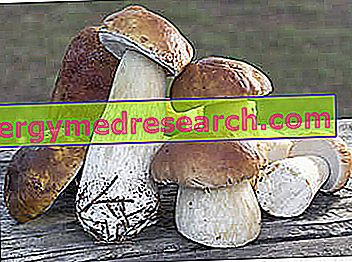Generality
Porcini are a group of basidiomycete fungi belonging to the Boletaceae family and to the genus Boletus .
Identified with the binomial nomenclature Boletus edulis, in French they are called Cèpe de Bordeaux, while in English they are known as cep, penny bun or king bolete .

In the past, many European mushrooms with characteristics similar to those of porcini were considered varieties of B. edulis, but molecular phylogenetic analysis has denied this hypothesis; curiously, however, other fungi previously classified as species in themselves, have become conspecific to porcini mushrooms.
The species of western North America known as california king bolete ( Boletus edulis var. Grandedulis ) is a darker colored variety formally identified only in 2007.
Description

The surface of these pores is whitish in color at a young age and evolves into a greenish-yellow when fully ripe (see image).
The stem or stem of the porcini is robust, white or yellowish, up to 25cm long and 10cm wide; it is superficially covered by a light layer of lattices .
Nutritional Features
Porcini are foods of fungal origin (non-vegetable), therefore vegetarian, vegan and potentially raw food users are admitted to the lacto-ovo diet.
Fresh porcini mushrooms contain about 80% water, although this value depends on the weather conditions at the time of development and processing; they have a low fat and carbohydrate content, while they have a higher quantity of proteins with a medium biological value.
Total glucides (including those not available) make up the majority of the boletus fruit-bearing body, or more than 9.23% of the fresh weight and 65.4% of the dry weight. These are mainly soluble monosaccharides - such as glucose, mannitol (not available) and alpha trehalose - and insoluble polysaccharides (up to 80-90% of dry matter in cell walls) such as glycogen and chitin.
Chitin, hemicellulose and pectin (not available) represent the dietary fiber of porcini mushrooms.
In porcini, total lipids make up 2.6% of the dry matter. The proportion of fatty acids (expressed in% of the total) is: palmitic acid 9.8%; 2.7% stearic acid; oleic acid 36.1%; linoleic acid 42.2% and linolenic acid 0.2%.
A comparative study of the amino acid composition of eleven Portuguese edible fungi showed that Boletus edulis has the highest total amino acid content. All 20 essential and many non-essential amino acids are included.
The analysis of free amino acids (ie those not bound in proteins) revealed higher concentrations of glutamine, alanine (both about 25% of the total) and lysine .
The nutritional role of porcini is above all to provide some vitamins, mineral salts and dietary fiber (the aforementioned carbohydrates not available).
The porcini metal and mineral composition values are quite different depending on the source of research; this is due to the fact that the fungi accumulate different elements and that the concentrations in the fruiting bodies are often variable based on the composition of the soil.
In general, porcini mushrooms contain appreciable amounts of selenium (an antioxidant and a useful element for thyroid function); however, its bioavailability is considered quite modest.
Wild porcini contain good amounts of vitamin D2 proper ( ergocalciferol ), but its concentrations seem lower in cultivated mushrooms (concentrations strongly depend on exposure to sunlight, even after they have been collected). Also the amount of vit E ( tocopherols ) is not negligible.
Furthermore, porcini mushrooms contain good amounts of ergosterol (precursor of vit D); it is a relatively high intake that makes porcini mushrooms extremely interesting for vegetarians and vegans, who often suffer from a vitamin deficiency due to their diet. For ergosterol to be converted into vitamin D2, the fungus must be exposed to ultraviolet light from the sun; this reaction takes place even after the harvest, therefore some researchers have come to the conclusion that it would be good to expose the mushrooms for about 60 minutes in the sun before cooking them and eating them .
Porcini produce other organic compounds with different biological activities; among these, antivirals, antioxidants and phytochelatins are famous (they promote the body's resistance to toxic metals of a toxic nature).

Chemical structure of (from left to right): ergosterol; ergocalciferol (Vitamin D2) ergosterol peroxide.
Bio-Active Porcini Compounds
As anticipated, porcini mushrooms contain excellent amounts of ergosterol. In addition, they provide ergosterol peroxide, a steroid derivative with a broad spectrum of biological activity, including antimicrobial, anti-inflammatory and cytotoxic functions for some tumor cells (effect observed in vitro).
Porcini also contain lectin, which has an affinity for xylose and melibiose . Lectin is a mitogenic compound, meaning it can stimulate cells to begin the replication process with consequent mitosis. Furthermore, lectin has known antiviral properties as it inhibits the viral enzyme reverse transcriptase of human immunodeficiency.
Other studies suggest that porcini also perform an antiviral activity against the Vaccinia virus and the tobacco mosaic virus .
Mushroom antiviral compounds are of interest in biomedical research, thanks to their power to improve knowledge about viral replication and potential utility in treating infections.
Porcini have a high antioxidant capacity, probably due to the combination of various organic acids ( oxalic, citric, malic, succinic and fumaric ), tocopherols, phenolic compounds and alkaloids .
The most developed antioxidant activity is located inside the mushroom chapels. Furthermore, it is estimated that porcini can contain up to 528mg of ergotionein (sulfur amino acid with antioxidant action) per kilogram of fresh mushrooms, one of the highest values found in the foods examined.
According to Hungarian research conducted in 1950, porcini could boast a certain anti-cancer capacity but, following other US investigations, the hypothesis has been denied.
Gastronomic outline
Appreciated as ingredients of great value in many recipes, porcini are edible mushrooms both raw and cooked.
The gastronomic use of porcini includes the formulation of some first courses such as soups, pasta, risottos, polenta, etc. In addition, they enrich numerous meat-based dishes such as, for example, fricassee stews; there is also some combination of crustaceans (mazzancolle) and porcini.
Porcini mushrooms are also added in recipes of intermediate value, appetizers, salads or unique dishes, such as bruschetta, pizza, raw salads, sandwiches etc.
Heavy Metal Contamination
Porcini are known to be able to tolerate and even thrive on soils contaminated with toxic heavy metals, such as near foundries.
As anticipated, the resistance of the fungus to the toxicity of heavy metals is conferred by a biochemical compound called phytochelatin oligopeptide, whose production is induced by exposure to the metal itself.
Phytochelatins are chelating agents capable of forming multiple bonds with metal. In this form, the contaminant is unable to react with other surrounding elements or ions and is stored in a non-toxic variant within the tissues.
Commodity
Despite being sold commercially, porcini mushrooms are still very difficult to grow.
In Europe, porcini mushrooms are available in fresh form especially in late summer and autumn; in the other seasons, instead, they are distributed frozen or dried or in brine.
Famous, and awarded the IGP (Typical Geographical Indication) mark, are the porcini mushrooms from Borgotaro.
Habitat
Ceps grow in broad-leaved and coniferous forests, or in plantations, forming symbiotic ectomycorrhizal associations that surround the underground roots of plants with fungal tissue sheaths.
The fungus produces fruiting bodies (what is commonly understood as a fungus) of spores that come out of the ground in the seasons of summer and autumn.
Related species
Various Species of mushrooms similar to porcini properly so called are considered of the subspecies or simple varieties. In Europe, in addition to the B. edulis (or Cèpe de Bordeaux ), the most popular pseudo-porcini (Species of Boletus) are:
- Tête de Nègre ("negro head" or rather Boletus aereus ), much rarer than B. edulis, is the most appreciated by gourmets and also the most expensive. It is usually smaller and darker than B. edulis and lends itself very well to drying
- Cèpe des pins ("pine tree boletus " or rather Boletus pinophilus or Boletus pinicola ); obviously it grows among the pines. Rarer than B. edulis, it is less appreciated by gourmets than the other two types but remains superior to almost all others.
- Cèpe d'été ("summer boletus " or Boletus reticulatus ), is even less common and earlier than the others.
Including the edulis, these are the four independent Species of Boletus present in Europe; as far as the subspecies of the edulis is concerned, however, we can see: betulicola, chippewaensis, persoonii, quercicola and venturii .



